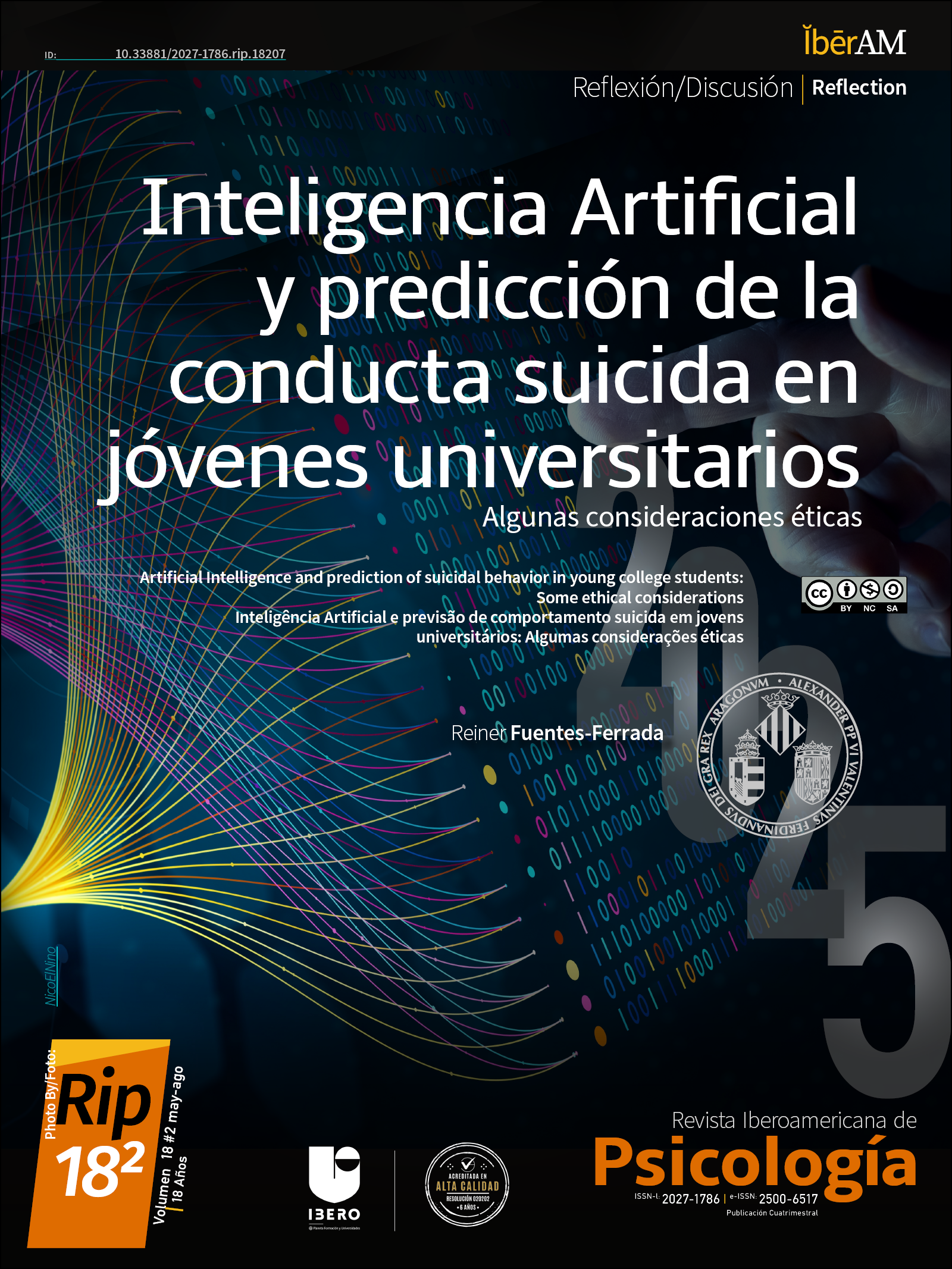Artificial Intelligence and prediction of suicidal behavior in young college students, some ethical considerations.
Inteligencia Artificial y predicción de la conducta suicida en jóvenes universitarios, algunas consideraciones éticas.
Main Article Content
New advances in artificial intelligence are promising for the field of predicting suicidal behavior. A high prevalence of mental health problems is evident in young university students. The implementation of predictive tools based on artificial intelligence in university contexts is incipient and requires reflection and some ethical safeguards for the approach of suicidal risk profiles in university students. This paper aims to briefly introduce the use of artificial intelligence in the prediction of suicidal behavior in university contexts and to develop some associated ethical considerations. The ethical considerations are related to the need for dialogue between updated suicidology studies and artificial intelligence innovations; the approach of referral after suicide risk screening and delimiting human capabilities not replaceable by artificial intelligence in suicide risk assessment. Suggestions and implications in discussions are discussed.
Publication Facts
Reviewer profiles N/A
Author statements
- Academic society
- Bogotá: Corporación Universitaria Iberoamericana
- Publisher
- Bogotá: Corporación Universitaria Iberoamericana
Article Details
Auerbach, R. P., Alonso, J., Axinn, W. G., Cuijpers, P., Ebert, D. D., Green, J. G., Hwang, I., Kessler, R. C., Liu, H., Mortier, P., Nock, M. K., Pinder-Amaker, S., Sampson, N. A., Aguilar-Gaxiola, S., Al-Hamzawi, A., Andrade, L. H., Benjet, C., Caldas-de-Almeida, J. M., Demyttenaere, K., Florescu, S., de Girolamo, G., Gureje, O., Haro, J., Karam, E., Kiejna, Kiejna, A., Kovess-Masfety, V., Lee, S., McGrath, J., O Neill, S., Pennel, B., Scott, K., ten Have, M., Torre, Y., Zaslavsky, A., Zarkov, Z., & Bruffaerts, R. (2016). Mental disorders among college students in the World Health Organization World Mental Health Surveys. Psychological Medicine, 46(14), 2955-2970. https://doi.org/10.1017/S0033291716001665
Barzilay, S., Assounga, K., Veras, J., Beaubian, C., Bloch-Elkouby, S., & Galynker, I. (2020). Assessment of near-term risk for suicide attempts using the Suicide Crisis Inventory. Journal of affective disorders, 276, 183-190.
Brailovskaia, J., Teismann, T., & Margraf, J. (2020). Positive mental health, stressful life events, and suicide ideation. Crisis.
Benjet, C., Borges, G., Miah, S., Albor, Y., Gutiérrez-García, R. A., Berbena, A. Z., Guzmán, R., Vargas-Contreras, E., Hernández Uribe, P. C., Quevedo, G., Díaz, A. C., Ruiz, S. M., Valdés-García, K. P., Martínez Jerez, A. M., & Mortier, P. (2022). One-year incidence, predictors, and accuracy of prediction of suicidal thoughts and behaviors from the first to second year of university. Depression and Anxiety, 39(12), 727-740. https://doi.org/10.1002/da.23278
Bishop, C. M. (2006). Pattern recognition and machine learning (Information science and statistics). Springer-Verlag New York, Inc.
Branley-Bell, D., O'Connor, D. B., Green, J. A., Ferguson, E., O'Carroll, R. E., & O'Connor, R. C. (2019). Distinguishing suicide ideation from suicide attempts: Further test of the Integrated Motivational-Volitional Model of Suicidal
Behaviour. Journal of Psychiatric Research, 117, 100-107. https://doi.org/10.1016/j.jpsychires.2019.07.007
Bloch-Elkouby, S., Gorman, B., Lloveras, L., Wilkerson, T., Schuck, A., Barzilay, S., ... & Galynker, I. (2020). How do distal and proximal risk factors combine to predict suicidal ideation and behaviors? A prospective study of the narrative crisis model of suicide. Journal of Affective Disorders, 277, 914-926.
Burke, T. A., Ammerman, B. A., & Jacobucci, R. (2019). The use of machine learning in the study of suicidal and non-suicidal self-injurious thoughts and behaviors: A systematic review. Journal of affective disorders, 245, 869-884. https://doi.org/10.1016/j.jad.2018.11.073
Cohen, L. J., Mokhtar, R., Richards, J., Hernandez, M., Bloch‐Elkouby, S., & Galynker, I. (2022). The narrative‐crisis model of suicide and its prediction of near‐term suicide risk. Suicide and Life‐Threatening Behavior, 52(2), 231-243. https://doi.org/10.1111/sltb.12816
Cardona, T., Cudney, E. A., Hoerl, R., & Snyder, J. (2023). Data mining and machine learning retention models in higher education. Journal of College Student Retention: Research, Theory & Practice, 25(1), 51-75. https://doi.org/10.1177/1521025120964920
Cash, S. J., Thelwall, M., Peck, S. N., Ferrell, J. Z., & Bridge, J. A. (2013). Adolescent suicide statements on MySpace. Cyberpsychology, Behavior, and Social Networking, 16(3), 166-174. https://doi.org/10.1089/cyber.2012.0098
Corke, M., Mullin, K., Angel-Scott, H., Xia, S., & Large, M. (2021). Meta-analysis of the strength of exploratory suicide prediction models; from clinicians to computers. BJPsych open, 7(1), e26. http:/doi.org/doi:10.1192/bjo.2020.162
do Espirito Santo Freire, K., Ribeiro Cortez Cardozo Barata de Almeida Hessel , B., Dazzani, M. V. M., & Marsico, G. (2023). Afiliación de estudiantes universitarios: un análisis desde la Psicología Cultural Semiótica: An analysis based on cultural semiotic psychology. Revista Iberoamericana de Psicología, 16(3), 35–44. https://doi.org/10.33881/2027-1786.rip.16304
Drousiotis, E., Joyce, D. W., Dempsey, R. C., Haines, A., Spirakis, P. G., Shi, L., & Maskell, S. (2023, June). Probabilistic decision trees for predicting 12-month university students likely to experience suicidal ideation. In IFIP International Conference on Artificial Intelligence Applications and Innovations (pp. 475-487). Cham: Springer Nature Switzerland.
Eskin, M., Sun, J. M., Abuidhail, J., Yoshimasu, K., Kujan, O., Janghorbani, M., Flood, C., Giovanni, M., Tran, U., Mchri, A., Hamdan, M., Poyrazli, S., Aidoudi, K., Bakhshi, S., Harlak, H., Moro, M., Nawafleh, H., Phillips, L., Shaheen, A., Taifour, S., Tsuno, K., & Voracek, M. (2016). Suicidal behavior and psychological distress in university students: a 12-nation study. Archives of suicide research, 20(3), 369-388. https://doi.org/10.1080/13811118.2015.1054055
Franklin, J. C., Ribeiro, J. D., Fox, K. R., Bentley, K. H., Kleiman, E. M., Huang, X., Musacchio, K. M., Jaroszewski, A. C., Chang, B. P., & Nock, M. K. (2017). Risk factors for suicidal thoughts and behaviors: A meta-analysis of 50 years of research. Psychological Bulletin, 143(2), 187–232. https://doi.org/10.1037/bul0000084
Galynker, I. (2023). The suicidal crisis: Clinical guide to the assessment of imminent suicide risk. Oxford University Press.
Galynker, I., Yaseen, Z. S., Cohen, A., Benhamou, O., Hawes, M., & Briggs, J. (2017). Prediction of suicidal behavior in high risk psychiatric patients using an assessment of acute suicidal state: The suicide crisis inventory. Depression and anxiety, 34(2), 147-158
Gotelli, M., Manríquez, J., Zambrano, C., Yañez, E., & Fuentes, R. (2023). Caracterización clínica y sociodemográfica del intento suicida en la Región de Los Ríos, Chile. Revista chilena de neuro-psiquiatría, 61(1), 32-42. http://dx.doi.org/10.4067/S0717-92272023000100032
Haghish, E. F., Czajkowski, N. O., & Von Soest, T. (2023). Predicting suicide attempts among Norwegian adolescents without using suicide-related items: A machine learning approach. Frontiers in Psychiatry, 14, 1216791. https://doi.org/10.3389/fpsyt.2023.1216791
Han, K., Ji, L., Chen, C., Hou, B., Ren, D., Yuan, F., ... & He, G. (2022). College students’ screening early warning factors in identification of suicide risk. Frontiers in genetics, 13, 977007. https://doi.org/10.3389/fgene.2022.977007
Hayes, S. C., Ciarrochi, J., Hofmann, S. G., Chin, F. & Sahdra, B. (2022). Evolving an idionomic approach to processes of change: Towards a unified personalized science of human improvement. Behaviour research and therapy, 156, 104155. https://doi.org/10.1016/j.brat.2022.104155
Heckler, W. F., de Carvalho, J. V., & Barbosa, J. L. V. (2022). Machine learning for suicidal ideation identification: A systematic literature review. Computers in Human Behavior, 128, 107095.
Heckler, W. F., de Carvalho, J. V., & Barbosa, J. L. V. (2022). Machine learning for suicidal ideation identification: A systematic literature review. Computers in Human Behavior, 128, 107095. https://doi.org/10.1016/j.chb.2021.107095
Heisel, M. J., Neufeld, E., & Flett, G. L. (2016). Reasons for living, meaning in life, and suicide ideation: investigating the roles of key positive psychological factors in reducing suicide risk in community-residing older adults. Aging & mental health, 20(2), 195-207. https://doi.org/10.1080/13607863.2015.1078279
Høyen, K. S., Cohen, L. J., Solem, S., Prestmo, A., Sørensen, K., Salvesen, Ø., Hjemdal, O., Vaaler, A. E., & Torgersen, T. (2023). Exploring associations between the Modular Assessment of Risk for Imminent Suicide (MARIS) questionnaire and recent suicidal ideation and behavior among patients admitted at an acute psychiatric inpatient department. Nordic Journal of Psychiatry, 77(3), 266–275. https://doi.org/10.1080/08039488.2022.2100929
Hirsch, J. K., Kelliher Rabon, J., & Chang, E. C. (2018). Applied resiliency and suicide prevention: A strengths-based, risk-reduction framework. A positive psychological approach to suicide: Theory, research, and prevention, 301-319.
Hubers, A. A. M., Moaddine, S., Peersmann, S. H. M., Stijnen, T., Van Duijn, E., Van der Mast, R. C., Dekkers, O. M., & Giltay, E. J. (2018). Suicidal ideation and subsequent completed suicide in both psychiatric and non-psychiatric populations: a meta-analysis. Epidemiology and psychiatric sciences, 27(2), 186-198. https://doi:10.1017/S2045796016001049
Huggett, C., Gooding, P., Haddock, G., Quigley, J., & Pratt, D. (2022). The relationship between the therapeutic alliance in psychotherapy and suicidal experiences: A systematic review. Clinical psychology & psychotherapy, 29(4), 1203-1235. https://doi.org/10.1002/cpp.2726
Inusah, F., Missah, Y. M., Najim, U., & Twum, F. (2022). Data mining and visualisation of basic educational resources for quality education. International Journal of Engineering Trends and Technology, 70(12), 296-307.
Issah, I., Appiah, O., Appiahene, P., & Inusah, F. (2023). A systematic review of the literature on machine learning application of determining the attributes influencing academic performance. Decision analytics journal, 100204. https://doi.org/10.1016/j.dajour.2023.100204
Ji, S., Pan, S., Li, X., Cambria, E., Long, G., & Huang, Z. (2020). Suicidal ideation detection: A review of machine learning methods and applications. IEEE Transactions on Computational Social Systems, 8(1), 214-226.
Joiner I. A. (2018). Artificial intelligence: AI is nearby. In Joiner I. A. (Ed.), Emerging library technologies (pp. 1–22). Chandos Publishing. https://doi.org/10.1016/B978-0-08-102253-5.00002-2
Joiner, T. E. (2005). Why people die by suicide. Harvard University Press.
Kelliher Rabon, J., Hirsch, J. K., & Chang, E. C. (2018). Positive psychology and suicide prevention: An introduction and overview of the literature. A positive psychological approach to suicide: Theory, research, and prevention, 1-15.
Kim, S., Lee, H. K., & Lee, K. (2021). Detecting suicidal risk using MMPI-2 based on machine learning algorithm. Scientific Reports, 11(1), 15310. https://doi.org/10.1038/s41598-021-94839-5
Kirlic, N., Akeman, E., DeVille, D. C., Sí, H. W., Cosgrove, K. T., McDermott, T. J., Touthang, J., Clausen, A., Paulus, M., & Aupperle, R. L. (2023). A machine learning analysis of risk and protective factors of suicidal thoughts and behaviors in college students. Journal of American College Health, 71(6), 1863-1872. https://doi.org/10.1080/07448481.2021.1947841
Kirtley, O. J., van Mens, K., Hoogendoorn, M., Kapur, N., & de Beurs, D. (2022). Translating promise into practice: a review of machine learning in suicide research and prevention. The Lancet Psychiatry, 9(3), 243-252. https://doi.org/10.1016/S2215-0366(21)00254-6
Kleiman, E. M. (2020). Suicidal thinking as a valuable clinical endpoint. EClinicalMedicine, 23, 100399. https://doi.org/10.1016/j.eclinm.2020.100399.
Klonsky, E. D., & May, A. M. (2014). Differentiating suicide attempters from suicide ideators: A critical frontier for suicidology research. Suicide and Life‐Threatening Behavior, 44(1), 1-5. https://doi.org/10.1111/sltb.12068
Klonsky, E. D., & May, A. M. (2015). The three-step theory (3ST): A new theory of suicide rooted in the “ideation-to-action” framework. International Journal of Cognitive Therapy, 8(2), 114–129. https://doi.org/10.1521/ijct.2015.8.2.114.
Klonsky, E. D., Qiu, T., & Saffer, B. Y. (2017). Recent advances in differentiating suicide attempters from suicide ideators. Current opinion in psychiatry, 30(1), 15-20. https://doi.org/10.1097/YCO.0000000000000294
Langer, Á. I., Schmidt, C., Martínez, V., Mac-Ginty, S., Fuentes, R., & Núñez, D. (2024). Suicidal ideation, non-suicidal self-injury and psychopathology in university students: Examining the moderating role of experiential avoidance. Journal of Affective Disorders Reports, 16, 100734. https://doi.org/10.1016/j.jadr.2024.100734
Large, M. M. (2018). The role of prediction in suicide prevention. Dialogues in clinical neuroscience, 20(3), 197-205. https://doi.org/10.31887/DCNS.2018.20.3/mlarge
Le, T. N., Kielburger, L. C., & Buddharakkhita, B. (2018). The six R’s framework as mindfulness for suicide prevention. A Positive Psychological Approach to Suicide: Theory, Research, and Prevention, 247-284.
Lee, J., & Pak, T. Y. (2022). Aprendizaje de máquinas prediction of suicidal ideation, planning, and attempt among Korean adults: A population-based study. SSM-Population Health, 19, 101231. https://doi.org/10.1016/j.ssmph.2022.101231
Liao, S., Wang, Y., Zhou, X., Zhao, Q., Li, X., Guo, W., ... & Qiu, P. (2022). Prediction of suicidal ideation among Chinese college students based on radial basis function neural network. Frontiers in public health, 10, 1042218. https://doi.org/10.3389/fpubh.2022.1042218
Linthicum, K. P., Schafer, K. M., & Ribeiro, J. D. (2019). Machine learning in suicide science: Applications and ethics. Behavioral sciences & the law, 37(3), 214-222. https://doi.org/10.1002/bsl.2392
Lichtenthaler, U. (2018). Substitute or synthesis: the interplay between human and artificial intelligence. Research-technology management, 61(5), 12-14. https://doi.org/10.1080/08956308.2018.1495962
Macalli, M., Navarro, M., Orri, M., Tournier, M., Thiébaut, R., Côté, S. M., & Tzourio, C. (2021). A machine learning approach for predicting suicidal thoughts and behaviours among college students. Scientific reports, 11(1), 11363.
Machado, C. dos S., Ballester, P. L., Cao, B., Mwangi, B., Caldieraro, M. A., Kapczinski, F., & Passos, I. C. (2022). Prediction of suicide attempts in a prospective cohort study with a nationally representative sample of the US population. Psychological Medicine, 52(14), 2985–2996. http:/doi.org/doi:10.1017/S0033291720004997
Mann, J. J., Waternaux, C., Haas, G. L., & Malone, K. M. (1999). Toward a clinical model of suicidal behavior in psychiatric patients. American journal of Psychiatry, 156(2), 181-189. https://doi.org/10.1176/ajp.156.2.181
Mora Romo, J. F., & Martell Muñoz, J. (2021). Predicción de efectos fisiológicos causados por el estrés académico mediante redes neuronales artificiales. Revista Iberoamericana de Psicología, 14(3), 25–37. https://doi.org/10.33881/2027-1786.rip.14303
McHugh, C. M., & Large, M. M. (2020). Can machine-learning methods really help predict suicide?. Current opinion in psychiatry, 33(4), 369-374. http:/doi.org/10.1097/YCO.0000000000000609
Miller DD, & Brown EW (2018) Artificial intelligence in medical practice: The question to the answer? The American Journal of Medicine 131: 129–133. https://doi.org/10.1016/j.amjmed.2017.10.035
Mukku, L., & Thomas, J. (2023). A machine learning model to predict suicidal tendencies in students. Asian Journal of Psychiatry, 79, 103363. https://doi.org/10.1016/j.ajp.2022.103363
Naghavi, A., Teismann, T., Asgari, Z., Mohebbian, M. R., Mansourian, M., & Mañanas, M. Á. (2020). Accurate diagnosis of suicide ideation/behavior using robust ensemble machine learning: a university student population in the Middle East and North Africa (MENA) Region. Diagnostics, 10(11), 956.
https://doi.org/10.3390/diagnostics10110956
O’Connor, R. C. (2011). The integrated motivational-volitional model of suicidal behavior. Crisis, 32, 295–298. https://doi.org/10.1027/0227-5910/a000120.
Radwin, D. (2009). High response rates don’t ensure survey accuracy (October 5 ed.): Chronicle of Higher Education.
Rossi, J., Jiménez, J., Barros, P., Assar, R., Jaramillo, K., Herrera, L., Quevedo, Y., Botto, A., Leighton, C. & Martínez, F. (2019). Sintomatología depresiva y bienestar psicológico en estudiantes universitarios chilenos. Revista Médica De Chile, 147(5), 579-588. https://doi.org/10.4067/s0034-98872019000500579
Rubiano, S. M. M., & Garcia, J. A. D. (2016). Analysis of data mining techniques for constructing a predictive model for academic performance. IEEE Latin America Transactions, 14(6), 2783-2788. https://doi.org/10.1109/TLA.2016.7555255
Rudd, M., Bryan, C. J., & Jobes, D. A. (2022). A standard protocol for the clinical management of suicidal thoughts and behavior: implications for the suicide prevention narrative. Frontiers in psychiatry, 13, 929305.
Sara, S. S., Rahman, M. A., Rahman, R., & Talukder, A. (2024). Prediction of suicidal ideation with associated risk factors among university students in the southern part of Bangladesh: machine learning approach. Journal of affective disorders, 349, 502-508. https://doi.org/10.1016/j.jad.2024.01.092
Sequeira, L., Strudwick, G., De Luca, V., Strauss, J., & Wiljer, D. (2022). Exploring uniformity of Clinical Judgment: a Vignette Approach to understanding Healthcare professionals’ suicide risk Assessment practices. Journal of patient safety, 18(6), e962-e970. https://doi.org/10.1097/PTS.0000000000000000973
Siegmann, P., Willutzki, U., Fritsch, N., Nyhuis, P., Wolter, M., & Teismann, T. (2019). Positive mental health as a moderator of the association between risk factors and suicide ideation/behavior in psychiatric inpatients. Psychiatry Research, 273, 678-684.
Shim, G., & Jeong, B. (2018). Predicting suicidal ideation in college students with mental health screening questionnaires. Psychiatry investigation, 15(11), 1037. https://doi.org/10.30773/pi.2018.08.21.3
Schuck, A., Calati, R., Barzilay, S., Bloch‐Elkouby, S., & Galynker, I. (2019). Suicide Crisis Syndrome: A review of supporting evidence for a new suicide‐specific diagnosis. Behavioral sciences & the law, 37(3), 223-239. https://doi.org/10.1002/bsl.2397
Stritzke, W. G. K., & Page, A. C. (2020). Suicide is about life. In C. Page y W. Stritzke (eds.), Alternatives to Suicide: Beyond Risk and Toward and Life Worth Living (pp. 3–14). Elsevier inc.
Thakkar, A., Gupta, A., & De Sousa, A. (2024). Artificial intelligence in positive mental health: a narrative review. Frontiers in Digital Health, 6, 1280235.
Tavory, T. (2024). Regulating AI in Mental Health: Ethics of Care Perspective. JMIR Mental Health, 11(1), e58493.
Terra, M., Baklola, M., Ali, S., & El-Bastawisy, K. (2023). Opportunities, applications, challenges and ethical implications of artificial intelligence in psychiatry: a narrative review. The Egyptian Journal of Neurology, Psychiatry and Neurosurgery, 59(1), 80. https://doi.org/10.1186/s41983-023-00681-z
Turecki, G., Brent, D. A., Gunnell, D., O’Connor, R. C., Oquendo, M. A., Pirkis, J., & Stanley, B. H. (2019). Suicide and suicide risk. Nature reviews Disease primers, 5(1), 74. https://doi.org/10.1038/s41572-019-0121-0
Valtonen, H. M., Suominen, K., Sokero, P., Mantere, O., Arvilommi, P., Leppämäki, S., & Isometsä, E. T. (2009). How suicidal bipolar patients are depends on how suicidal ideation is defined. Journal of Affective Disorders, 118(1-3), 48-54. https://doi.org/10.1016/j.jad.2009.02.008
Wampold, B. E., Baldwin, S. A., Holtforth, M. G., & Imel, Z. E. (2017). What characterizes effective therapists? In L. G. Castonguay & C. E. Hill (Eds.), How and why are some therapists better than others (pp. 37–53). American Psychological Association. https://doi.org/10.1037/0000034-003
Wiebenga, J. X., Eikelenboom, M., Heering, H. D., van Oppen, P., & Penninx, B. W. (2021). Suicide ideation versus suicide attempt: Examining overlapping and differential determinants in a large cohort of patients with depression and/or anxiety. Australian & New Zealand Journal of Psychiatry, 55(2), 167-179. https://doi.org/10.1177/0004867420951256
Yaseen, Z. S., Hawes, M., Barzilay, S., & Galynker, I. (2019). Predictive validity of proposed diagnostic criteria for the suicide crisis syndrome: an acute presuicidal state. Suicide and Life‐Threatening Behavior, 49(4), 1124-1135.
Zea, L. D. F., Reina, Y. F. P., & Molano, J. I. R. (2019). Machine learning for the identification of students at risk of academic desertion. In Learning Technology for Education Challenges: 8th International Workshop, LTEC 2019, Zamora, Spain, July 15–18, 2019, Proceedings 8 (pp. 462-473). Springer International Publishing.












